Francesca Busca
Year of birth: 1975.
Where do you live: London, UK / Trieste, Italy.
Your education: Classics, Law with European Legal Studies (and Legal Practice Course), Mosaic and Fine Arts.
Describe your art in three words: Pioneering Sustainable Art.
Your discipline: mosaics, mixed media, installations, layered photography.
www.francescabusca.art | Instagram
Could you tell us about your journey from being a city solicitor to becoming an eco-artivist and mosaicist?
I always practiced art as a way of life. Whether selling my drawings on the street or collecting the wax from the candle trays in churches to re-melt and model as a child, drawing huge drapes with medieval life scenes for a medieval fair by using material and techniques of the time as a teenager or frantically modelling clay as a solicitor, art has always played an essential role in my life. For some perverse misconception, I always thought that art came too easy and was too much fun to be a job. So, I chose what suited me the least instead, to make up for ’lacks’ in my character, and I studied and/or practiced Law in Padua, London, Paris and NYC.
After the children – and a striking visit to the mosaics in Aquileia, in Italy – I finally gave in to my nature and graduated with distinction in Mosaic and Fine Arts at the London School of Mosaic in 2019, where I also lectured the Mosaic Fabrication module in 2021/22.
Having explored various professions throughout my career, ranging from interior designer to in-house legal working with ex-CIA and ex-SAS agents, from City Solicitor to mosaicist and lecturer, I have finally found myself. Embracing unconventional paths and pioneering endeavours has been a recurring theme in my journey: and while I have achieved success in each undertaking, I have often felt like I was inhabiting someone else’s shoes, and this Impostor Syndrome is both daunting and fuelling my drive to continuously explore and expand my knowledge.
Also, art is only the last step in my journey – and this is why I call myself an eco-artivist, rather than an artist. Gesamtkunstwerk, my eco-artivism encompasses every aspect of my life: vegan, using 100% renewable energy, wearing second-hand clothes, being plastic free wherever possible, seeking local food and saving water, growing a vegetable and wildlife garden, experimenting with permaculture, fostering a passion for evolutionary ecology and vegetal neurobiology and not flying for the past 4 years, as I strive to live as sustainably as possible.
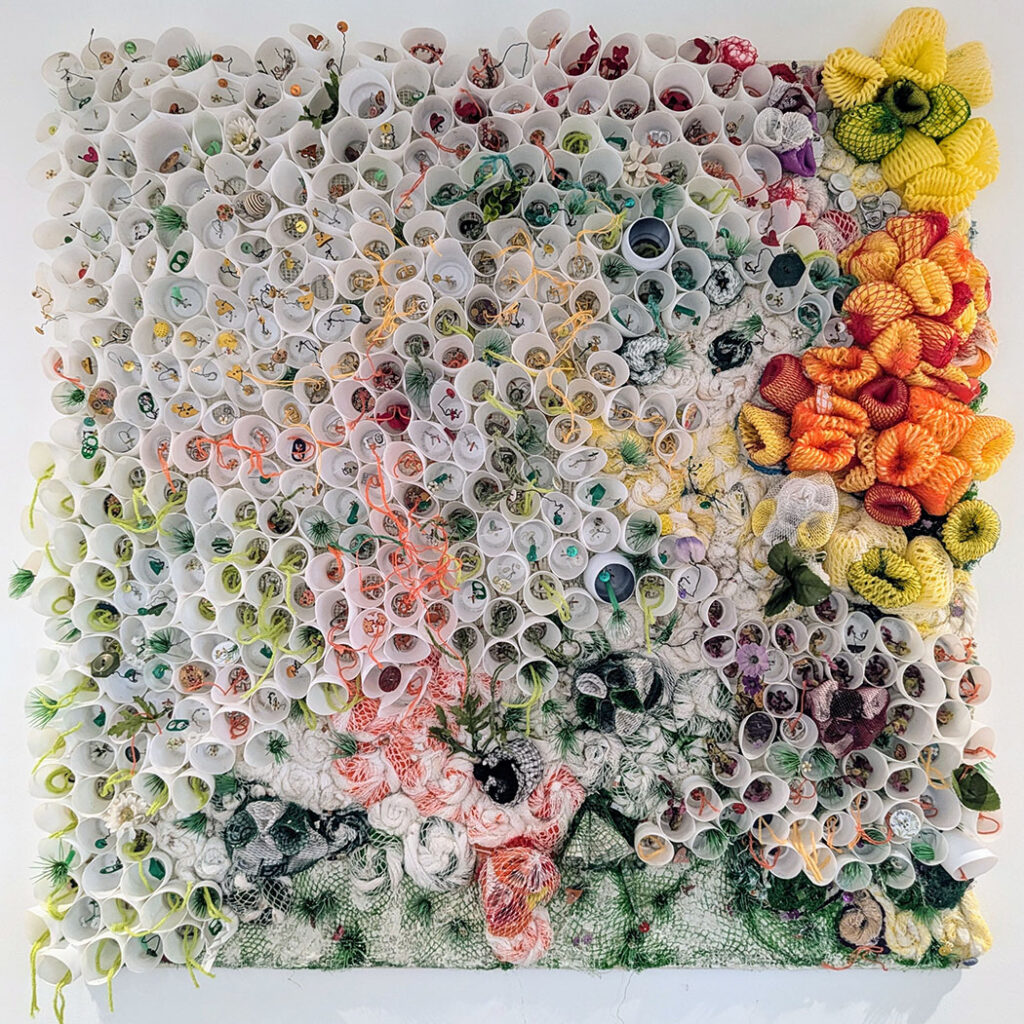 Francesca Busca | A Monumnet to Summer | 2024
Francesca Busca | A Monumnet to Summer | 2024
What inspired you to create artwork entirely out of waste materials?
Since nowadays we plunder more that twice the sustainable amount of Earth’s resources worldwide, I wanted to minimise my impact as much as possible. I noticed that the viewers were more intrigued by the material used than the meaning conveyed by the artworks, which were inevitably focused more and more on the need to reconnect with the eco-system and to shift from an anthropocentric society to one focused on the common good of the whole, until this urge I feel for it simply and naturally overtook my life.
How do you select the materials for your projects? Do you have any criteria for what kind of waste you use?
I try to use as un-recyclable a material as possible. For example, I stopped storing cans as metal is the only infinitely recyclable resource at the moment, though I still use caps as they are not yet recyclable – at least in the UK. I keep telling my clients who get an artwork made with them that they are not only getting an artwork, but also a stash of material which is becoming increasingly precious with time ;).
I love the challenge of trying new materials, although I have indeed tried most already. My favourite is probably my mum’s plastic medicine vials, which she takes once a day. I like having to wait for years to use them, knowing that in a given number of years there will be exactly that certain amount to use.
Otherwise, most of my projects are material driven, so they influence the size and/or the shape of the artwork consistently. When on an Art for Trash commission, I love to think on my feet. Though of course I go through phases, I do appreciate constant stimuli with new materials and especially environments. Residencies are so much fun, and such boost to creativity! Now that my children have grown up enough, I am really looking forward to new experiences in new spaces, as varied as possible.
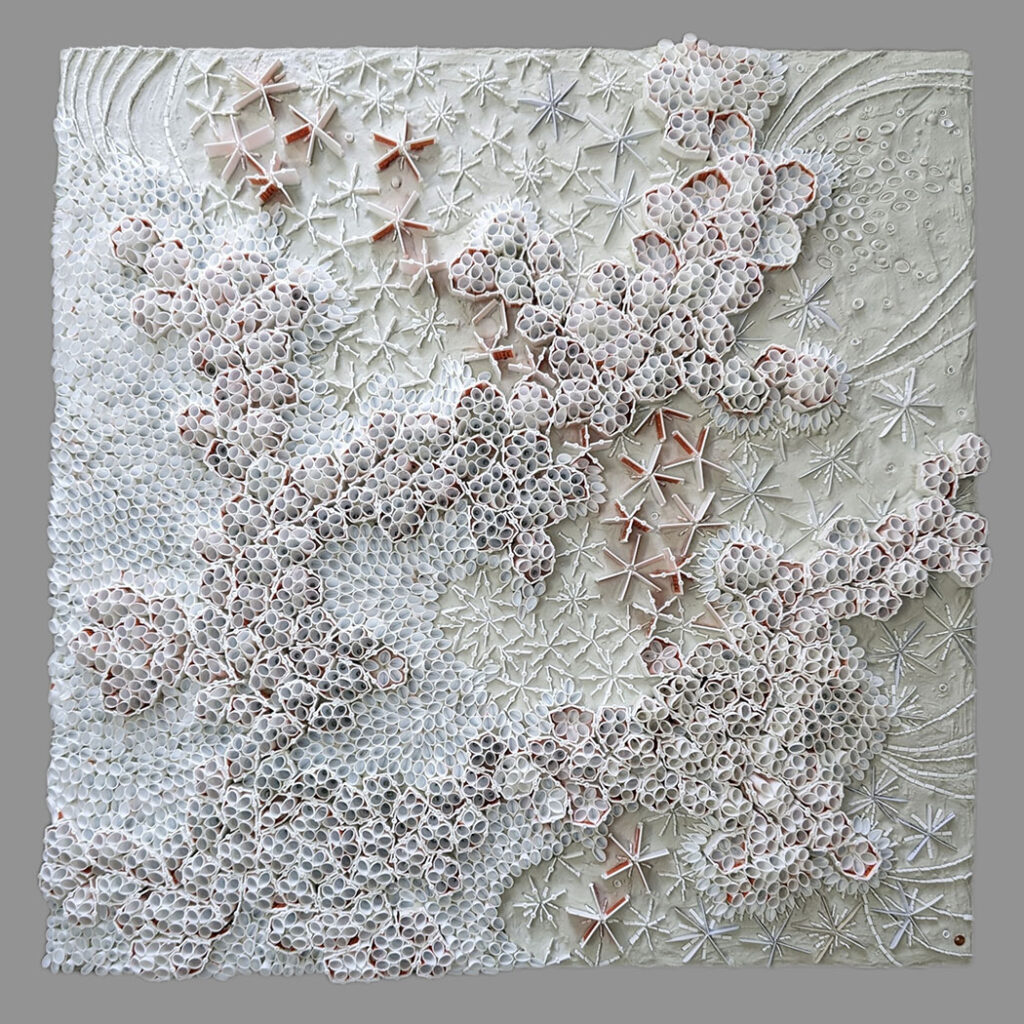 Francesca Busca | Cinderella Tries the Shoe (Impostor Syndrome) | 2024
Francesca Busca | Cinderella Tries the Shoe (Impostor Syndrome) | 2024
Your project ‘Payment in Kind(ness)’ is quite unique. Can you explain how it works and what inspired this concept?
In May 2018 I launched the Payment in Kind(ness) initative at my Little Things solo in the lobby of Bridgeman House on High Street Kensington, in London. The spirit of this exhibition was to foster the public’s attention to what I called ‘Little Things’, namely eco-friendly gestures, as an incentive to Re-thinking, Re-using, Re-purposing and Reducing (ideally pReventing!), and I started accepting Little Things as a “Payment in Kind(ness)” towards any of my artworks on sale.
And I keep it going: there is a list of Little Things on my website, and if you are interested in one of my available pieces I will accept any of those towards the price of the artwork. All you have to do is to 1) take a picture of your Little Thing, 2) tag me on IG (@francesca_busca) or LinkedIn, identify it as #littlethings #paymentinkindness and its number, and I will keep track!
Can you share some insights from your year-long collaboration with the Institute of Marine Sciences in Venice?
It was a truly enriching experience. Born from the idea of an Art for Trash project, which is another initiative of mine whereby I make artwork for corporate, institutional and residential premises by using the client’s waste, I spent a year collaborating with the institute both to understand what each researcher and lab did and to see what waste they produced, so that we could decide which items they could then keep on the side for me. It then culminated in a 2 weeks’ residency at their institute in May, whereby I made the artwork in loco by using such waste from their labs, offices, research platform and vessel, and even some grout and debris which had fallen from their XV c. building at the Arsenale. “Sea It!” was then shown at the Venice Boat Show 2024, acting as a bridge between science and the public and opening a dialogue with and between both worlds on the state of our seas, and what we could do to help.
We also created a training for trainers, available for free from the Institute (please contact me if you would like a copy! The institute would be thrilled) which aims at fostering knowledge, love and care for our seas and oceans. Personally, I enjoyed the collaboration tremendously, as the researchers were extremely welcoming, helpful and collaborative. Not only the legacy of what I learnt will keep developing and inspire me in my work, but I also feel that we established a lovely and vibrant bond which in fact brought the institute to ask me to collaborate with them further in the next few years, also with some prestigious art institutions in Venice. I am over the moon!
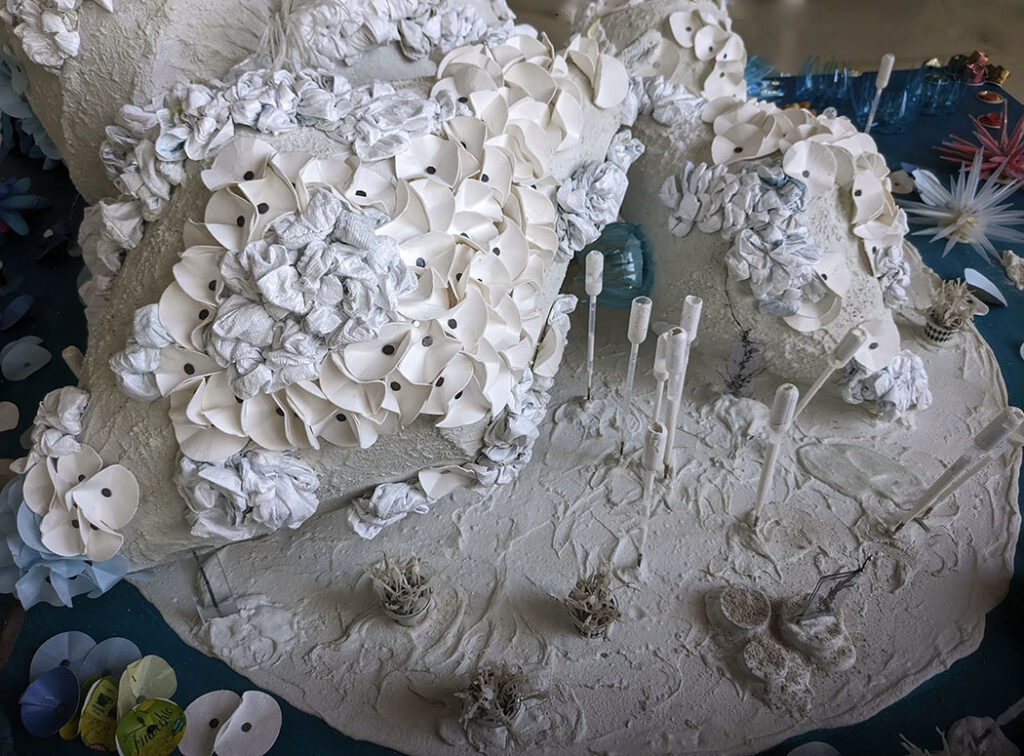 Francesca Busca | Sea It! | 2024
Francesca Busca | Sea It! | 2024
What are some challenges you face when creating art from waste materials?
As some of these materials are quite tricky to hold together, they require thorough thinking and experimenting with the adhesive. For example, as you might know, there are hundreds of different kinds of plastic which behave very differently from one another to different adhesives and surfaces. The risk is that the waste, probably sectioned even further by me, will then fall off and pollute more than before I worked on it. Also, I cannot solve the problem lightly by using toxic glues, as again, that would create even more pollution. Personally, I resort to washable PVA wherever possible, or otherwise to eco-friendly cement, even when the material still does not stick to it: in that case in fact I fold or shape the material in such a way that the tiles are kept to the board by being stuck under the layer of hard cement. I thoroughly enjoy this challenge, even if it means having to work in small sections with lots of weights and supports around and above them, and having to wait a few hours between sections, until the adhesive is dry, before resuming.
What advice would you give to aspiring artists who wish to work with sustainable materials?
Please do!!! Waste can be such beautiful material, and using it is like shopping at a vintage store, offering you all sorts of styles and colours. And when you do, please think carefully about the impact it can have, by using the most eco-friendly adhesives, tools, exhibiting devices, etc. Should you need advice, please do contact me and I will be thrilled to share tips if I can! You can find me on @francesca_busca on Instagram. Get in touch!
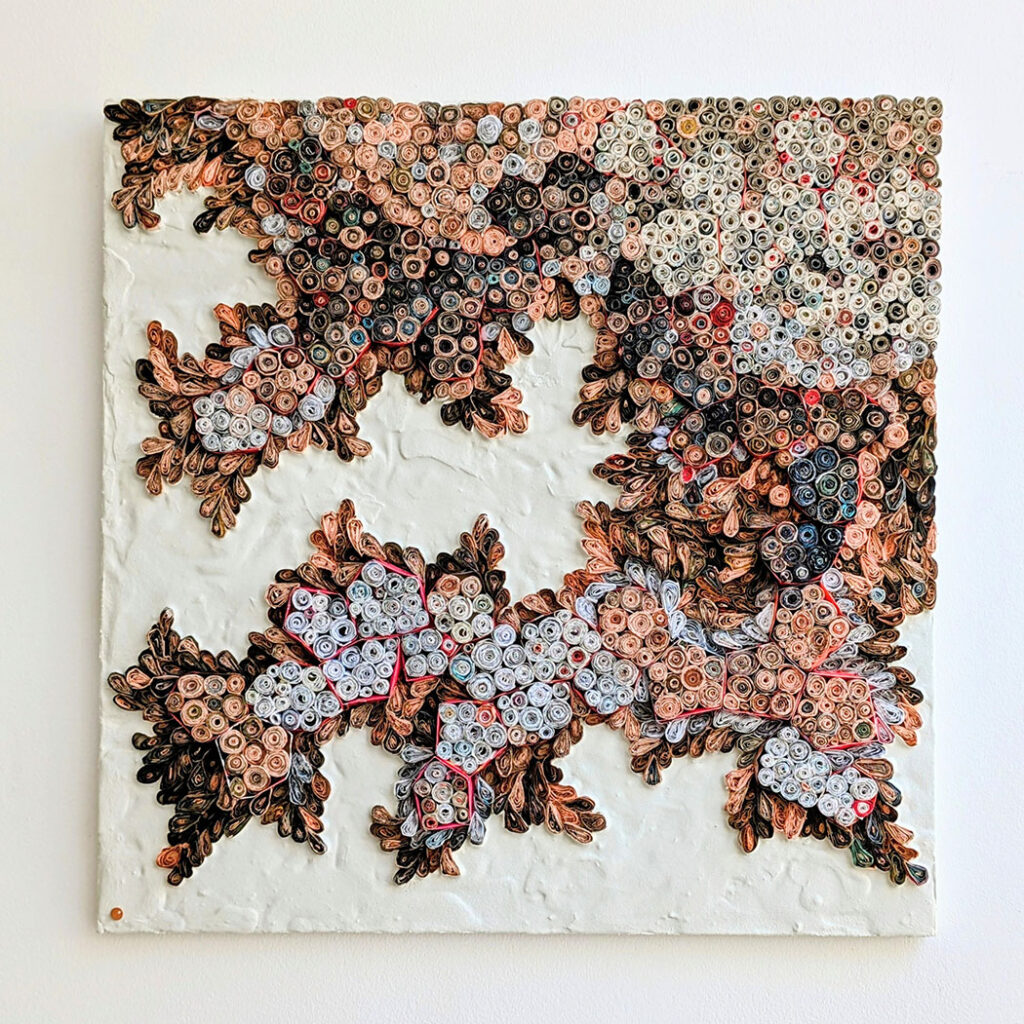 Francesca Busca | Red Tape | 2024
Francesca Busca | Red Tape | 2024

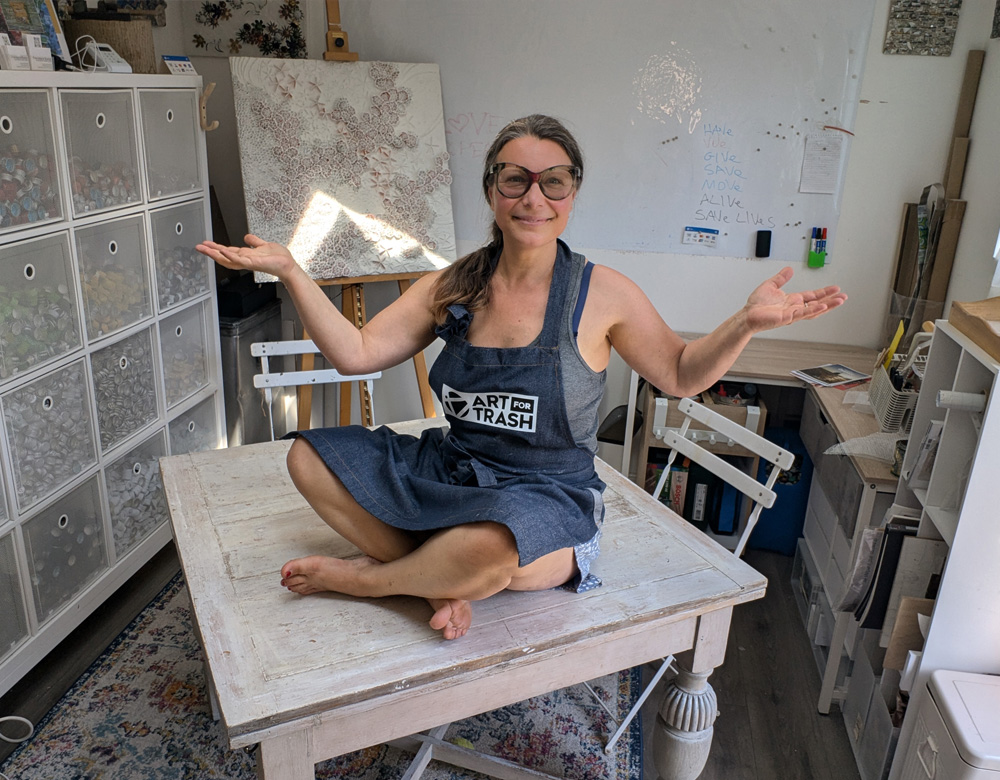
Leave a Reply
You must be logged in to post a comment.